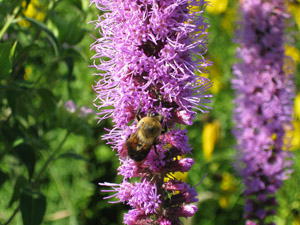Pollinator Losses in the Northeastern United States
 |
|
A bumble bee on Liatris pycnostachya, prairie blazing star. Source: C. Neal, UNH Cooperative Extension. |
One in every three bites of food is attributable to insect pollination. With insect pollinators so vital to food production, national and global reports of their decline are concerning.
In the United States, commercially managed honey bees are essential in pollinator-dependent agricultural systems. These colonies are often trucked across the continent to pollinate large plantings of fruit and nut crops such as almonds, apples, blueberries, cucurbits, and a variety of seed crops.
There is a difference between colony losses and colony population declines. Beekeepers who suffer losses can quickly replace “dead out” colonies by splitting live colonies and adding a queen to the split. This practice is expensive both in terms of labor and lost productivity. Anticipating higher losses, many commercial beekeepers have increased the number of colonies they take into the fall. The story is different in the Northeast, where the top five honey-producing states saw the number of managed colonies decrease from 94,000 in 2008 to 89,000 in 2013, a 5.3 percent reduction.
The status of non-apis pollinators is more difficult to pin down. An analysis of Northeastern U.S. bee specimens collected over a span of 140 years revealed the persistence of native species as a group with only “modest” richness declines. Out of 187 native species examined for relative abundance only three Bombus species were identified as having rapid declines. However, large community shifts were noted, as 56 percent of species experienced considerable changes in relative abundance; over time the numbers of exotic bees steadily rose by 27 percent while the numbers of native bees dropped by 29 percent.
The U.S. Geological Survey began funding a systematic count of native bee species in 2010. Their goal is to better understand native bee populations, which have not been studied as extensively as managed honey bees.
—by Andrew Garavito, Lisa Kuder, and Nathalie Steinhauer
of the Dennis vanEngelsdorp lab, Department of Entomology, University of Maryland
The Northeastern IPM Center promotes integrated pest management for reducing risks to human health and the environment. If republishing our news, please acknowledge the source (“From Northeast IPM Insights”) along with a link to our website.
